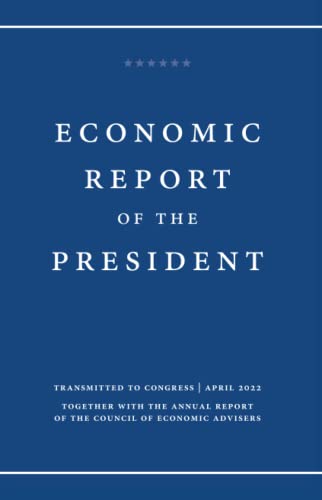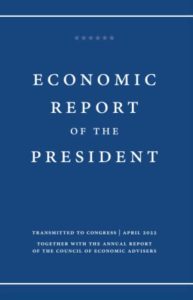

One of the few bright spots in the 2022 Economic Report of the President is the section on occupational licensing. Here are two key paragraphs (from pages 152-153):
Occupational licensing policies are often introduced to ensure safe, high-quality services from professionals, like dentists and electricians, whose safety and quality are difficult for consumers to ascertain themselves. These policies frequently establish minimum standards for workers’ human capital investments—such as by mandates to acquire specific credentials or to pursue continuing education. Kleiner and Soltas (2019) show that these standards induce workers who enter these occupations to invest more than they otherwise would, especially in occupation-specific forms of human capital such as vocational associate degrees and master’s degrees.
However, occupational licensing can make it more difficult for workers to enter fields or move to places where their human capital would be more productive by increasing the cost of mobility in terms of fees for obtaining a license or time to complete required training or other licensing requirements. Research finds that licensing requirements decrease employment and churn within an occupation (Blair and Chung 2019; Kleiner and Soltas 2019; Kleiner and Xu 2020). On the positive side, licensing increases wages and wage growth within licensed occupations (Kleiner and Krueger 2010, 2013; Gittleman, Klee, and Kleiner 2017; Kleiner and Soltas 2019; Kleiner and Xu 2020). One analysis suggests that the magnitude of the licensing wage premium is comparable to the premium associated with union membership (Kleiner and Krueger 2010). Though licensed workers may benefit from higher wages, other similarly skilled workers who lack the resources to acquire a license may be prevented from moving into jobs where they would be more productive and better paid. There is also evidence that occupational licensing reduces interstate migration (Johnson and Kleiner 2020), making it more difficult for workers to relocate and deploy their human capital where it would be most beneficial for them. This especially affects mobile populations such as military spouses, who are 10 times more likely to have moved across State lines in the last year than their civilian counterparts and experience persistently high unemployment due to relocations (U.S. Department of the Treasury and U.S. Department of Defense 2012).
Not bad. I’ll highlight and comment on a few things, in order of their appearance.
Occupational licensing policies are often introduced to ensure safe, high-quality services from professionals, like dentists and electricians, whose safety and quality are difficult for consumers to ascertain themselves.
There’s actually very little evidence, at least that I know of, that this was an important purpose of occupational licensing. It was an important stated rationale, but that’s different. Typically, the people lobbying for occupational licensing are the existing members of the occupation. They make the safety/quality argument, but if safe, high-quality services were the main goal, one would expect to see consumers, at least occasionally, pushing for licensing. It’s true that a given consumer does not have much incentive to do so, but organizations like Consumers Union do, if they regard this as a problem.
Also, although “safety and quality are difficult for consumers to ascertain themselves,” this is true only in a narrow sense; they can ascertain quality if they rely on various certifiers, certifiers that already exist and that would be more numerous if licensing didn’t exist. Think of Underwriters Laboratories for many products, for instance, or the Physician’s Desk Reference, which guides doctors on pharmaceuticals.
Kleiner and Soltas (2019) show that these standards induce workers who enter these occupations to invest more than they otherwise would, especially in occupation-specific forms of human capital such as vocational associate degrees and master’s degrees.
That’s true, and it’s probably not good.
The very next sentence is:
However, occupational licensing can make it more difficult for workers to enter fields or move to places where their human capital would be more productive by increasing the cost of mobility in terms of fees for obtaining a license or time to complete required training or other licensing requirements.
True, but there shouldn’t be a “However.” It’s the very fact that occupational licensing induces workers to invest more than they otherwise would that’s a problem. That’s why occupational licensing makes “it more difficult for workers to enter fields or move to places where their human capital would be more productive by increasing the cost of mobility in terms of fees for obtaining a license or time to complete required training or other licensing requirements.”
Research finds that licensing requirements decrease employment and churn within an occupation (Blair and Chung 2019; Kleiner and Soltas 2019; Kleiner and Xu 2020).
Yes.
On the positive side, licensing increases wages and wage growth within licensed occupations (Kleiner and Krueger 2010, 2013; Gittleman, Klee, and Kleiner 2017; Kleiner and Soltas 2019; Kleiner and Xu 2020).
Hmmm. That’s like looking at the local-government-sponsored cable monopolies in the United States before there were competing alternatives and saying, “On the positive side, regulation to limit competition increases the amount of money earned by cable companies.” The CEA shouldn’t celebrate monopoly rents.
One analysis suggests that the magnitude of the licensing wage premium is comparable to the premium associated with union membership (Kleiner and Krueger 2010).
I think this is their subtle way of saying, “Don’t take our previous sentence as indicating anything other than monopoly power due to government restrictions.”
Though licensed workers may benefit from higher wages, other similarly skilled workers who lack the resources to acquire a license may be prevented from moving into jobs where they would be more productive and better paid.
Ok. Now they really seem to be telling the reader not to regard the higher wages to licensed workers as an unmitigated benefit.
There is also evidence that occupational licensing reduces interstate migration (Johnson and Kleiner 2020), making it more difficult for workers to relocate and deploy their human capital where it would be most beneficial for them. This especially affects mobile populations such as military spouses, who are 10 times more likely to have moved across State lines in the last year than their civilian counterparts and experience persistently high unemployment due to relocations (U.S. Department of the Treasury and U.S. Department of Defense 2012).
Good for them for pointing this out. They could also have pointed out that in 2019, the Arizona state government “became the first state to recognize all out‐of‐state occupational and professional licenses.” They didn’t mention this. Is this because the legislation in Arizona that did so was passed by a Republican-majority legislature and signed by a Republican governor?
One of the links in the above two quoted paragraphs from the Economic Report of the President is to Morris M. Kleiner and Evan J. Soltas, “A Welfare Analysis of Occupational Licensing in U.S. States,” October 2019. Kleiner is the guy when it comes to analysis of occupational licensing. Soltas is a staff economist at the Council of Economic Advisers, on leave from MIT where he is getting his Ph.D. in economics. I’ve been around the blogging world enough to remember that people were citing his work when he was a precocious high schooler. Here’s the abstract of the Kleiner/Soltas study:
We assess the welfare consequences of occupational licensing for workers and consumers. We estimate a model of labor market equilibrium in which licensing restricts labor supply but also affects labor demand via worker quality and selection. On the margin of occupations licensed differently between U.S. states, we find that licensing raises wages and hours but reduces employment. We estimate an average welfare loss of 12 percent of occupational surplus. Workers and consumers respectively bear 70 and 30 percent of the incidence. Higher willingness to pay offsets 80 percent of higher prices for consumers, and higher wages compensate workers for 60 percent of the cost of mandated investment in occupation-specific human capital.

READER COMMENTS
pyroseed13
Apr 27 2022 at 4:55pm
“One analysis suggests that the magnitude of the licensing wage premium is comparable to the premium associated with union membership (Kleiner and Krueger 2010).”
Hmm this makes me wonder: It’s a little odd to see a group that often defends unions complain about occupational licensing. The economic effects are basically the same: Generally rents for one group at the expense of another. Is the argument that occupational licensing is often a regressive policy and that unions are progressive?
David Henderson
Apr 27 2022 at 5:54pm
Good question.
I see two possibilities:
(1) They think unions are good because–unions.
(2) Behind closed doors, they share some of the free labor market people’s criticisms of unions, but don’t dare say so.
Thomas Lee Hutcheson
Apr 27 2022 at 9:36pm
That may be it but for slightly different reasons. A union can only successfully gain income for its members from a monopolistic firms and so sharing in the firms monopoly rents at the expense of owners, presumably a progressive transfer of income. Occupational licensing for doctors and car dealers creates the monopoly that licensees enjoy and the transfer of income is regressive. Licensing for professions in which customers are of higher incomes than licensees, can possible be a progressive transfer of income.
Phil H
Apr 29 2022 at 2:35am
I don’t know if anyone will know this off the top, but I thought I’d ask. One of the arguments for licensing is that consumers may have difficulty recognising high-quality practitioners. But in theory at least, businesses have more resources and more incentive to invest resources in identifying good suppliers. Is there evidence on the relative prevalence and impact of occupational licensing in consumer services versus business services? It’s possible that kind of data might tell us something about the consumer ignorance argument.
Josh King
Apr 29 2022 at 4:15pm
They could also have pointed out that in 2019, the Arizona state government “became the first state to recognize all out‐of‐state occupational and professional licenses.”
Well, almost all licenses. To no one’s surprise, the Arizona Bar has held onto its lawyer licensing monopoly.
john hare
May 5 2022 at 4:14am
Apologies for the late response. Catching up on posts that were invisible on my desktop for a few days.
One of the other problems with licensing is that it restricts production of things people want. I am still waiting on “engineered” blueprints so I can get a permit and build my house. Many months lost on work I could do myself in a long weekend if it were legal.
Comments are closed.